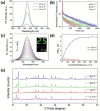Printing High-Efficiency Perovskite Solar Cells in High-Humidity Ambient Environment-An In Situ Guided Investigation
- PMID: 33747734
- PMCID: PMC7967091
- DOI: 10.1002/advs.202003359
Printing High-Efficiency Perovskite Solar Cells in High-Humidity Ambient Environment-An In Situ Guided Investigation
Abstract
Extensive studies are conducted on perovskite solar cells (PSCs) with significant performance advances (mainly spin coating techniques), which have encouraged recent efforts on scalable coating techniques for the manufacture of PSCs. However, devices fabricated by blade coating techniques are inferior to state-of-the-art spin-coated devices because the power conversion efficiency (PCE) is highly dependent on the morphology and crystallization kinetics in the controlled environment and the delicate solvent system engineering. In this study, based on the widely studied perovskite solution system dimethylformamide-dimethyl sulfoxide, air-knife-assisted ambient fabrication of PSCs at a high relative humidity of 55 ± 5% is reported. In-depth time-resolved UV-vis spectrometry is carried out to investigate the impact of solvent removal and crystallization rate, which are critical factors influencing the crystallization kinetics and morphology because of adventitious moisture. UV-vis spectrometry enables accurate determination of the thickness of the wet precursor film. Anti-solvent-free, high-humidity ambient coatings of hysteresis-free PSCs with PCEs of 21.1% and 18.0% are demonstrated for 0.06 and 1 cm2 devices, respectively. These PSCs exhibit comparable stability to those fabricated in a glovebox, thus demonstrating their high potential.
Keywords: air‐knife assisted drying; blade coating; crystallization; nucleation; perovskite solar cells; scalable ambient fabrication.
© 2021 The Authors. Advanced Science published by Wiley‐VCH GmbH.
Conflict of interest statement
The authors declare no conflict of interest.
Figures







Similar articles
-
Efficient Blade-Coated Wide-Bandgap and Tandem Perovskite Solar Cells via a Three-Step Restraining Strategy.Adv Mater. 2025 Feb;37(7):e2414790. doi: 10.1002/adma.202414790. Epub 2024 Nov 19. Adv Mater. 2025. PMID: 39558775
-
Dependence of Acetate-Based Antisolvents for High Humidity Fabrication of CH3NH3PbI3 Perovskite Devices in Ambient Atmosphere.ACS Appl Mater Interfaces. 2018 May 16;10(19):16482-16489. doi: 10.1021/acsami.8b02554. Epub 2018 May 7. ACS Appl Mater Interfaces. 2018. PMID: 29733567
-
Controlling the Morphology and Interface of the Perovskite Layer for Scalable High-Efficiency Solar Cells Fabricated Using Green Solvents and Blade Coating in an Ambient Environment.ACS Appl Mater Interfaces. 2020 Jun 10;12(23):26041-26049. doi: 10.1021/acsami.0c06211. Epub 2020 Jun 1. ACS Appl Mater Interfaces. 2020. PMID: 32434322
-
Strategies and Methods for Upscaling Perovskite Solar Cell Fabrication from Lab-Scale to Commercial-Area Fabrication.Molecules. 2025 May 20;30(10):2221. doi: 10.3390/molecules30102221. Molecules. 2025. PMID: 40430393 Free PMC article. Review.
-
Coated and Printed Perovskites for Photovoltaic Applications.Adv Mater. 2019 Jun;31(26):e1806702. doi: 10.1002/adma.201806702. Epub 2019 Apr 1. Adv Mater. 2019. PMID: 30932255 Review.
Cited by
-
Tailoring Crystal Growth Regulation and Dual Passivation for Air-Processed Efficient Perovskite Solar Cells.Adv Sci (Weinh). 2025 Apr;12(14):e2407401. doi: 10.1002/advs.202407401. Epub 2025 Feb 19. Adv Sci (Weinh). 2025. PMID: 39973078 Free PMC article.
-
Modeling and Fundamental Dynamics of Vacuum, Gas, and Antisolvent Quenching for Scalable Perovskite Processes.Adv Sci (Weinh). 2024 Apr;11(14):e2308901. doi: 10.1002/advs.202308901. Epub 2024 Feb 2. Adv Sci (Weinh). 2024. PMID: 38308172 Free PMC article.
-
Gas-Assisted Spray Coating of Perovskite Solar Cells Incorporating Sprayed Self-Assembled Monolayers.Adv Sci (Weinh). 2022 May;9(14):e2104848. doi: 10.1002/advs.202104848. Epub 2022 Feb 9. Adv Sci (Weinh). 2022. PMID: 35142096 Free PMC article.
-
Solvent engineering for scalable fabrication of perovskite/silicon tandem solar cells in air.Nat Commun. 2024 Jun 8;15(1):4907. doi: 10.1038/s41467-024-49351-5. Nat Commun. 2024. PMID: 38851760 Free PMC article.
-
Hot Gas-Blowing Assisted Crystallinity Management of Bar-Coated Perovskite Solar Cells and Modules.Small Sci. 2023 Jul 18;3(9):2300069. doi: 10.1002/smsc.202300069. eCollection 2023 Sep. Small Sci. 2023. PMID: 40212978 Free PMC article.
References
-
- Tan H., Jain A., Voznyy O., Lan X., García de Arquer F. P., Fan J. Z., Quintero‐Bermudez R., Yuan M., Zhang B., Zhao Y., Fan F., Li P., Quan L. N., Zhao Y., Lu Z.‐H., Yang Z., Hoogland S., Sargent E. H., Science 2017, 355, 722. - PubMed
-
- Yang S., Chen S., Mosconi E., Fang Y., Xiao X., Wang C., Zhou Y., Yu Z., Zhao J., Gao Y., De Angelis F., Huang J., Science 2019, 365, 473. - PubMed
-
- Liu M., Johnston M. B., Snaith H. J., Nature 2013, 501, 395. - PubMed
-
- Wang Z., Lin Q., Chmiel F. P., Sakai N., Herz L. M., Snaith H. J., Nat. Energy 2017, 2, 17135.
LinkOut - more resources
Full Text Sources
Other Literature Sources
